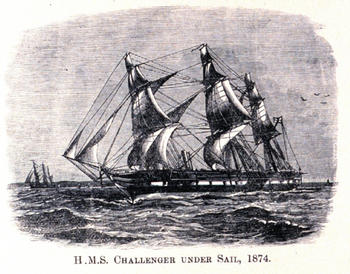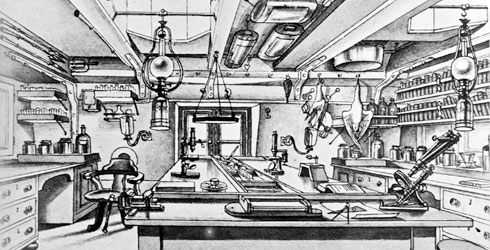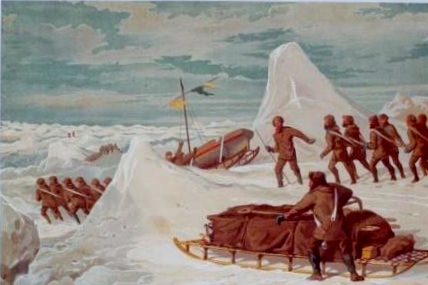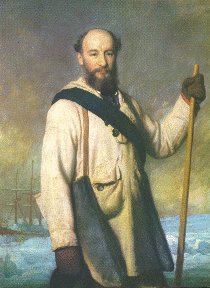Sir George Nares – Sailor, Explorer and Oceanographer – PART 2
In the two last postings on this blog (Click here if you’ve missed them) we’ve seen George Nares (1831-1915) rise through the ranks of the Royal Navy, get a taste for Arctic exploration and surveying and snatching the honour of commanding the first ship through the Suez Canal in 1869, ahead of that of the French Empress Eugenie. Despite being officially reprimanded for this embarrassment of the French, Nares was congratulated in private and promoted from commander to captain. He now landed one of the most prestigious assignments in the Navy – command of HMS Challenger on the scientific expedition of the same name. Setting out in late 1872, this undertaking was more ambitious by far than the voyage of the Beagle some four decades earlier.

This inspired project was funded by the British government to the level of £200,000 (worth at least fifty times as much today) and in view of what was achieved – essentially the creation of the science of Oceanography – represented extraordinarily good value. There had been extensive surveys made globally of coasts and inshore waters but very little was known about the ocean floors. It was a joint operation by the Royal Navy and the Royal Society, then the world’s premier scientific organisation, the Navy providing the ship and crew, the Royal Society the scientific team.

Laboratory on HMS Challenger
The Challenger was a Pearl-class corvette, launched in 1858 and of 2137 tons and 225 foot length, equipped both with sail and a 400 hp auxiliary steam engine. All but two of her guns were removed and laboratories, extra cabins and a special dredging platform installed. She was loaded with specimen jars, alcohol for preservation of samples, microscopes and chemical apparatus, trawls and dredges, thermometers and water sampling bottles, sounding leads and devices to collect sediment from the sea bed and great lengths of rope (181 miles!) for suspending equipment.

HMS Challenger Voyage – with acknowledgement to
the National Oceanic and Atmospheric Administration of the United States Department of Commerce
Over the four years of the expedition she was to cover 69,000 miles, as per the map above, most of them under Nares. He took with him his nine-year old son, William, (what a dream come true for any intelligent child!) who was accompanied by a tutor who died early in the voyage. The scientific team made observations, soundings and dredgings of marine fauna from hundreds of locations. Given the huge area covered, this information allowed determination of patterns of oceanic temperatures and currents as well as charting the contours of the great ocean basins. The “Nares Deep”, in the Western Atlantic was found to be 27,972 feet, and was the deepest known part of the world’s oceans at the time of its discovery. The expedition was subsequently to identify the well-named “Challenger Deep” in the Marianas Trench, the greatest depth of water – 35,814 feet – on earth.

Drawings, made on board, of marine organisms collected by the Challenger expedition
Apart from this bathymetric work, similarly important discoveries were made in the marine- biology area, over 4,000 previously unknown species being identified. For the first time on such an expedition extensive use was made of photography for recording. The management of ship, crew and logistics, so as to provide an efficient platform, distant from shore support, from which the scientists could operate, was an achievement of the highest order and one that attested to Nares’ mastery of his profession.

Challenger’s officers and scientific team – Nares (bearded) in centre
Nares did not stay with the Challenger expedition to the end, being recalled in in 1874 to take command of the forthcoming two-year British Arctic Expedition. The focus was on geographical exploration, scientific work being a secondary objective, with the North Pole, if at all possible, as the ultimate destination. Nares’ superb management and survey skills, and the fact that he had previous Arctic experience, made him the ideal choice. Two ships were made available, HMS Alert, a wooden sloop of the Cruizer class and HMS Discovery, a converted whaler.

HMS Discovery and HMS Alert in the ice
The expedition penetrated the channel between the West Coast of Greenland and Ellesmere Island – subsequently named the Nares Strait, and entered the Lincoln Sea to the north. Here Nares discovered extensive ice, disproving the theory common up to that time that the North Pole was surrounded by open sea. In the process HMS Alert reached the highest Northern latitude yet attained by any ship and one of the land parties broke the human record for the same achievement.

Man-hauled sleds on the Discovery/Alert expedition – clothing inadequate by modern standards
An unexpected problem now hit the expedition. For a century the Royal Navy had saved its sailors from scurvy by daily tots of lime juice (hence the expression “Limeys”) and during Nares’ Arctic expedition this regime was held to strictly. Inexplicably however, scurvy began to break out and became very severe, particularly among the sledging parties who were operating inland. With the situation not improving, Nares had the moral courage to abandon the expedition and to return to Britain late in 1876. Though the decision obviously saved a large number of lives, Nares was subjected to criticism for allowing the scurvy to develop in the first place, despite meticulous enforcement of lime-juice issue.
The explanation, when eventually found, absolved Nares from blame. Large glass bottles of lime juice were known to shatter in Arctic temperatures, though smaller ones apparently did not. The response, before the expedition, had been to distil the juice into concentrate. Copper vessels had been used in the distillation process but it was not known that copper leaches Vitamin C (undiscovered at that time) and heat destroys it. The concentrate was therefore missing the properties required and had no medicinal value whatsoever.

Cutting ice to free the ships

Nares was knighted on return from the Arctic and received various scientific honours. He was to take the Alert on one last surveying voyage, to the Magellan Straits, in 1878. Thereafter he returned to Britain and took up an appointment as Marine Adviser to the Board of Trade. His subsequent career was mainly concerned with harbour and navigation issues, both before and after his retirement from the Navy in 1886. He was promoted to Vice-Admiral while on the retired list and he continued to maintain an interest in Polar exploration, including being a committee member for organisation of Scott’s Antarctic expedition.
Nares was to live on to 1915, having witnessed, and being part of, a technical and scientific revolution. He deserves to be remembered.
Do you read on Kindle?
Like naval fiction?
Note that if you are an Amazon Prime subscriber you can borrow any one of the six Dawlish Chronicles novels, free each month. The novels are also available for purchase on Kindle. If you’re a Kindle Unlimited subscriber you can read any, at any time, without further charge.
Click on the image below for more details
Registering for the Dawlish Chronicles mailing list by clicking above, or on the banner below, will keep you updated on new books and facilitates e-mail contact between Antoine Vanner and his readers for discussion of issues arising.
Suggestions and constructive comment are always welcome and all emails are replied to. Free short stories, available only to those on the list, are also made available at intervals.



